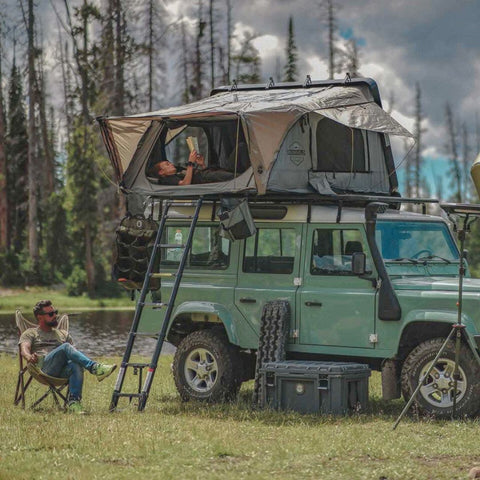Where Can You Camp With A Roof Top Tent?
Roof top tents have gained popularity over the years given how comfortable and convenient they are. Despite being more expensive than any ground tent, they are an investment on comfort, a good night sleep, a durable product and most importantly yearly adventures with friends and family. If you want more information about them, take a look at our roof top tent guide.
That said, most people interested in them keep asking the same question: where can you camp with a roof top tent? Well, besides the obvious answer which is RV parks or parking lots, we want to tackle the real question: are there camp sites, national parks, or other places where I can camp on a rooftop tent?
Yes. Now let’s take a look.
Do Campsites Allow Roof Tents?

Most campsites in the United States tend to allow roof tents, however, some might just let you camp either on the RV site area, or some on the parking lot, which isn’t ideal. That said, given the popularity of the tents, how safe they are with wildlife when compared to ground tents, and the fact that they don’t take as much space a RVs, mot camp grounds are much more open to let you camp with them on the regular camp site. As you may already know, most camp sites have a space dedicated to park your vehicle next to the flat ground area to set a ground tent, so it makes sense they allow RTTs as well, and they’ve started doing that a lot.
In this article you will find a list of some camp grounds close to some national parks that let you camp with tents. That said, we strongly recommend you personally calling the camp ground in advance to learn if there are any restrictions or if they are all good with you bringing an RTT. Remember, what we say today can change over time, rules change, etc. Call in advance.
Where Can I Camp On My Rooftop Tent?
National Parks:

Most national parks offer designated camping areas where you can set up a ground tent as well as your roof top tent. Call in advance to the exact park or site to understand first if there are restrictions, as well as which are the amenities they have: bathroom, shower, etc.
The parks will normally charge you a fee for spending the night or camping there, and despite most spots being for ground camping, there are more “modern” parks now offering spaces for roof top tents.
Be aware the public camping spots tend to follow some common rules, such as a first come first serve space basis, so if you get there late you run the risk of not finding any space to actually camp. In others, you’re able to make a reservation, so calling in advance or visiting the National Park website is a must.
Public Lands:
A public land is defined as a piece of land managed by an agency such as the US Forest Service, and some of them allow dispersed camping. To do so, you need to follow certain guidelines of safety, behavior, etc. Roof top tents tend to be much safer than a ground tent for secluded camping. Once again, do your research in advance.
Overland Routes:
Despite not being considered an official public land, and this being a grey area, overland routes will take you to far away places where you can camp on your roof top tent completely undisturbed. Most people won’t ever even find you, and you can camp on the side of the road or trail, or find a nice place in the middle of the forest.
Private Property:
Clearly, if you own a piece of land and want to camp in it, you can. Also, if you manage to get permission from a landowner, they will let you camp on their property. From personal experience, I once had the pleasure of camping on my Thule roof top tent on a private property close to Sedona in Arizona. It was getting late, we were looking for RV parks or places to camp, we found a restaurant along the road, asked if they knew, they called a friend, and 20 minutes later we were camping in their property, which needless to say was large enough for us to have privacy and not disturb anyone. It was great!
Campgrounds And RV Parks:
Don’t confuse camp grounds with the national park itself. There are national parks with space and permission for you to camp in them. Others don’t, and as a result there are many camp grounds that have been built in land very close to the national park. Similar to RV parks.
You can get to both campgrounds and RV parks to inquire if there is space for you to set up your tent, and you’ll be able to do so. A good tip is to check Hipcamp to know where exactly these camp grounds or parks are, and what their regulations are.
While roof top tents are more commonly associated with off-grid camping, they can also be used in traditional campgrounds and RV parks. Many campgrounds and RV parks have spaces designated for tent camping, and some may even allow roof top tents on vehicles.
Events & Festivals:
Although this is an overlanding website and we don’t really sell equipment for festivals, the truth is roof top tents have become popular for events such as Burning Man and many more. Rooftop tents are indeed a very comfortable and smart choice for festival and long event attendees to use. Most festivals have camp grounds or parking lots where they will allow you to sleep, camp, etc. You’ll save hundreds if not thousands on accommodation.
National Parks That Allow Roof Top Tents:
The following list contains 60 National Parks that allow roof top tent camping. We have personally tested some of them such as the Grand Canyon and Tonto in Arizona, Acadia in Maine, and Yellowstone. Some people have told us that they had issues in Yellowstone, but we personally didn’t after staying at Madison.
That said, given it can always change, we advice you visit the specific National Park website to inquire about the possibility, make reservations, so on and so forth. Remember, being responsible is always one of the most important things you can do!
- Yosemite National Park, California
- Grand Canyon National Park, Arizona
- Rocky Mountain National Park, Colorado
- Great Smoky Mountains National Park, Tennessee
- Zion National Park, Utah
- Joshua Tree National Park, California
- Acadia National Park, Maine
- Yellowstone National Park, Wyoming
- Glacier National Park, Montana
- Olympic National Park, Washington
- Big Bend National Park, Texas
- Arches National Park, Utah
- Sequoia and Kings Canyon National Parks, California
- Shenandoah National Park, Virginia
- Death Valley National Park, California/Nevada
- Redwood National and State Parks, California
- Bryce Canyon National Park, Utah
- Grand Teton National Park, Wyoming
- Everglades National Park, Florida
- Denali National Park and Preserve, Alaska
- White Mountain National Forest, New Hampshire
- Pisgah National Forest, North Carolina
- Coconino National Forest, Arizona
- San Juan National Forest, Colorado
- Deschutes National Forest, Oregon
- Olympic National Forest, Washington
- Angeles National Forest, California
- Chattahoochee-Oconee National Forest, Georgia
- Sierra National Forest, California
- Bridger-Teton National Forest, Wyoming
- Mount Hood National Forest, Oregon
- Mount Baker-Snoqualmie National Forest, Washington
- Ouachita National Forest, Arkansas/Oklahoma
- Custer State Park, South Dakota
- Mount Rainier National Park, Washington
- Lassen Volcanic National Park, California
- Crater Lake National Park, Oregon
- Great Basin National Park, Nevada
- Canyonlands National Park, Utah
- Petrified Forest National Park, Arizona
- Capitol Reef National Park, Utah
- Tonto National Park, Arizona
- Guadalupe Mountains National Park, Texas
- Carlsbad Caverns National Park, New Mexico
- Mammoth Cave National Park, Kentucky
- Great Sand Dunes National Park and Preserve, Colorado
- Big Bend Ranch State Park, Texas
- Assateague Island National Seashore, Maryland/Virginia
- Cape Hatteras National Seashore, North Carolina
- Padre Island National Seashore, Texas
- Apostle Islands National Lakeshore, Wisconsin
- Sleeping Bear Dunes National Lakeshore, Michigan
- Voyageurs National Park, Minnesota
- Olympic Peninsula, Washington
- Pisgah National Forest, North Carolina
- Joshua Tree National Park, California
- Zion National Park, Utah
- White Mountain National Forest, New Hampshire
- Glacier National Park, Montana
- Olympic National Park, Washington
Remember to verify camping regulations and availability at each location before planning your trip.



